Choosing your saber
Types of steels and blades (general)
No doubt, the katana is the weapon which has generated the most different forging techniques. The goal is to have a blade which is, on one hand, hard enough to be sharpened efficiently (because sharpening a too flexible blade implies that the edge will be damaged too quickly) and, on the other hand, enough supple because flexibility assists the blade to be solid and not to break at the slightest shock. It seems quite paradoxical, but as you are going to realize, this is perfectly mastered by the Japanese. Here is a presentation of the different types of blades. This article is intended to be an introduction to the different types of blades that we find today for the forging of modern and semi-industrial katanas. It is therefore not focused on the actual study of Nihontō as for the other articles. It is more intended for those who do not know much about it, and who possibly practice a sport related to the saber and want to be informed to better choose their katana in the current context (price indications etc ...). To stay simple, the blades are therefore ranked in ascending order of quality/rarity.
The Maru
At first, we often speak about Maru, or katana with carbon steel (abuse of language since steel is by definition iron containing carbon). These katanas were widely used during World War II (guntō). The goal is to control the carbon rate, which gives hardness to the blade, in order to produce a kind of steel which is both hard and flexible. So we say Maru 1045, containing 0.45% carbon, or Maru 1060 containing 0.60% carbon, and or Maru 1095... The 1095 is at the upper ranking for this kind of blade. Although less flexible than a 1045 or a 1060, it absorbs blows as well, and permits a greatly superior sharpening making it very incisive. There are many other grades, (1050, 1055, 1075...)
to differentiate them, they are classified as following :
to differentiate them, they are classified as following :
- Shigane or soft steel (1040 to 1050 on average)
- Kawagane or hard (1055 to 1075)
- Hagane or very hard (1080 to 1095, i.e. containing 0.80% to 0.95% carbon).
- Kawagane or hard (1055 to 1075)
- Hagane or very hard (1080 to 1095, i.e. containing 0.80% to 0.95% carbon).
Often we forget to mention that these characteristic rates are not only used to indicate the carbon content, but also the adding of some other steel admixtures, in particular chromium (which prevents the blade from rusting) and molybdenum (which prevents breakage of the blade). Thus a 1095 is perhaps by definition less flexible than a 1045, but it nevertheless contains more molybdenum to compensate, and this explains its place of favorites in the Maru ranking. Note that although it is absolutely not traditional, there are stainless steel blades in the marus. Actually a katana is classified in this category as soon as the level of chromium of the blade reaches 13%.
Generally , a 1045 costs between 100 and 150 dollards, a 1060 more like 160-170, and a 1095 can cost up to around 230 euros. These prices are only indicative, since the quality of the other materials is obviously taken into account.
A little bit of history :
Industrial steel Marus were mostly produce during World War II. Actually the Japanese sabers were initially made in Tamahagane (see below). But the classic steel is less expensive, and Japan having to assume the impossible (and in fact never reached) challenge to produce 2,000,000 sabers, the too rare and expensive Tamahagane had gone by the wayside. The Maru composition (a single grade of steel) is obviously the oldest type of blade, and the early Nihontōs were virtually all tamahagane Marus.
Industrial steel Marus were mostly produce during World War II. Actually the Japanese sabers were initially made in Tamahagane (see below). But the classic steel is less expensive, and Japan having to assume the impossible (and in fact never reached) challenge to produce 2,000,000 sabers, the too rare and expensive Tamahagane had gone by the wayside. The Maru composition (a single grade of steel) is obviously the oldest type of blade, and the early Nihontōs were virtually all tamahagane Marus.
Damascus blades
The damask steel katana consists of mixing hard steel (Hagane) with soft steel (Shigane) to have a hard blade but softer than a classic 1095. Forging a katana involves bending and striking the steel as many times as necessary to diffuse the rate of carbon and other elements to make the blade more homogeneous. This avoids weaknesses that increase the risk of breakage. Damascus is made up of layers of steel which are nevertheless clearly distinguishable, but the steel is still struck for this purpose. However compared to a Maru, the carbon is less diffused, but this is surprisingly the strength of the damask steel. And when perfectly achieved, it is excellent in efficiency and less easily chipped. Some would prefer a 1095 in terms of hardness for sports practice, but what makes Damascus so successful is its very particular ribbed aspect, but rather, take a look :

In addition, we notice that over time the edge of a damask saber seems particularly incisive, thanks to its structure (hard grains in a soft background), that makes them particularly effective for well "sawn" cuts. Indeed that is exactly what the Japanese martial arts know how to achieve. (for example consult the studies of B. ZSCHOKKE about the cutting edge of Damascus blades).
You have to know that today, damask blades are generally made with machine tools.
Indeed, the necessary work to realize such a blade is immense, and to have a more affordable price (generally 280-340 euros) it is a necessary bad bargain. However, if you are demanding, do not hesitate to contact the dealers : sometimes they can have damask blades made by hand (although this is relatively rare, and much more expensive).
Also you have to pay attention because there are false damask steels : a simple industrial rolling is made to obtain its characteristic aspect. Some do not hide it (and we can thank them by the way) as is the case of Mcusta, a Japanese forge of knives imitating damascus (their knives are really known to be of excellent quality). We also talk about acid treatment, allowing the patterns to stand out without affecting the technical quality of the blade, but making it perhaps a little more artificial or at least even a little more industrial.
Historically damask steel, also called wootz, does not come from the city of Damascus in Syria. Anyway it is not at all Japanese, but is still traditional since it arrived very early in Japan, and it was already used to forge the first curved sabers. Japan exploited this composition perfectly, and even today we can say that some Japanese sabers are part of the most beautiful damask steel blades. Notice that unlike Japan, damask steel has alternated periods of success and oblivion throughout the history of European blades.
You have to know that today, damask blades are generally made with machine tools.
Indeed, the necessary work to realize such a blade is immense, and to have a more affordable price (generally 280-340 euros) it is a necessary bad bargain. However, if you are demanding, do not hesitate to contact the dealers : sometimes they can have damask blades made by hand (although this is relatively rare, and much more expensive).
Also you have to pay attention because there are false damask steels : a simple industrial rolling is made to obtain its characteristic aspect. Some do not hide it (and we can thank them by the way) as is the case of Mcusta, a Japanese forge of knives imitating damascus (their knives are really known to be of excellent quality). We also talk about acid treatment, allowing the patterns to stand out without affecting the technical quality of the blade, but making it perhaps a little more artificial or at least even a little more industrial.
Historically damask steel, also called wootz, does not come from the city of Damascus in Syria. Anyway it is not at all Japanese, but is still traditional since it arrived very early in Japan, and it was already used to forge the first curved sabers. Japan exploited this composition perfectly, and even today we can say that some Japanese sabers are part of the most beautiful damask steel blades. Notice that unlike Japan, damask steel has alternated periods of success and oblivion throughout the history of European blades.
The composite blades
The composite blades are the very best proof of the undeniable talent of Japanese blacksmiths. They appeared during the Muromachi era (1392-1573) with the Makuri and the Kobuse. The principle : a hard steel on the surface, for a sharper edge, and a soft core for optimal shock absorption. The elasticity of these blades is excellent. Take a look at the impressive elaboration of these different compositions :

Dark blue: very hard steel (Hagane), Light blue: hard steel (Kawagane), Gray: soft steel (Shigane)
Some people would ask what is the difference between a Honsanmai (very liked composition) and an Orikaeshi sanmai. The Orikaeshi is a variant which is forged with 6 ingots (i.e. 6 kinds of steel) instead of 4. The core of the blade is multi-layers, this gives very much suppleness. But the difference in low, and as well as the Honsanmai which is highly valued, the Kobuse is also reputed for its little bit lower price, and its efficiency is not to be proved. Historically it is a well known composition. The Soshu Kitae blades are also highly valued. Initially they were forged by Masamune. They are more expensive but have a formidable efficiency. The composite blade cost varies within an average from 500 to 600 dollards, if not hand- made or without hamon. Often these blades are proposed with hamon, so the price is more than 1200 dollards.
The hamon, or heat treatment
Heat treatment is a forging technique that makes the edge extremely hard. To perform this treatment, the blacksmith spreads a mixture of refractory clay on the blade of the katana. A small thickness of this mixture on the cutting edge, then as we move away from it, we increase the thickness to reach up to 3cm. Thus, the clay will protect the blade and the treatment will only take place on the cutting edge. Then, the blade is heated to 800 ° and it is suddenly cooled in water or oil. This has the physical consequence of creating martensite, supersaturated with carbon, and therefore of incomparable hardness.
This quenching line being visible, it also has a particular aesthetic aspect, and we therefore unfortunately find false hamon. Here are some techniques to differentiate them, and not be charged for a decorative hamon :
Here we have a fake hamon obtained by grinding. It is very coarse and easily noticeable, since it is formed by lines perpendicular to the cutting edge, while a real hamon follows the usual grain of the katana.
This quenching line being visible, it also has a particular aesthetic aspect, and we therefore unfortunately find false hamon. Here are some techniques to differentiate them, and not be charged for a decorative hamon :
Here we have a fake hamon obtained by grinding. It is very coarse and easily noticeable, since it is formed by lines perpendicular to the cutting edge, while a real hamon follows the usual grain of the katana.
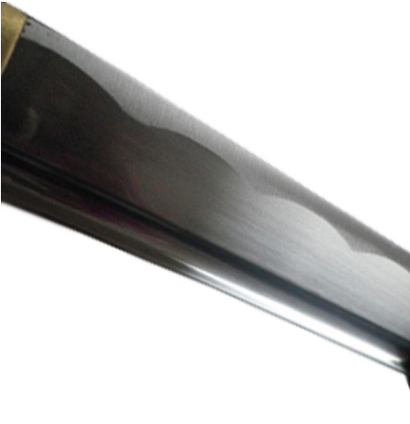
Others are made with acid, and are differentiable because they are much more visible than the classic hamon. However, today there are real hamons, nevertheless as visible as those made with acid. However, they stay quite in the minority, because they are produced by a very few western forges.
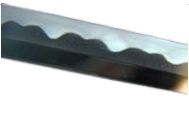
hamon with acide
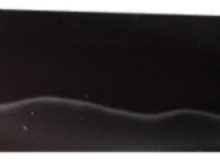
Real hamon
You have to know that a hamon is not directly visible, and that it is fully revealed during polishing. This polishing is long and difficult to achieve, that is why it often happens that the hamons are revealed by semi-industrial processes, with acid (even for real hamon). It is relatively regrettable since the quenching line becomes less aesthetic and less authentic, because it has no more the appearance of a real clay hamon, even though the blade do have one. For an expert the difference is clearly visible, since a hamon revealed by polishing has a cloudy appearance (white marks called Hataraki). See the difference :
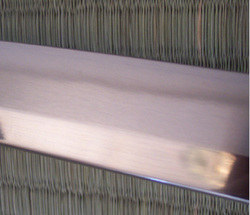
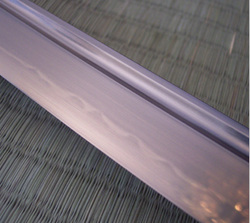
real hamon revealed by polishing
real hamon revealed with acid
A katana with hamon costs an average of 900 to over 1200 dollards if composite, less if you find 1045 katanas with hamon.
Tamahagane steel katanas
Tamahagane steel is the traditional steel from which ancient blades were forged. This steel is produced in a blast furnace, from ferruginous sand highly concentrated in molybdenum (which prevents breakage), and very little phosphorus (which on the contrary increases the probability of breakage). Thus, the blade is very resistant, and we can get on for a carbon rates of 1.5%, which permits a much higher sharpening (from 1.7% and over we obtain cast iron). Today there is a lot of confusion about the Tamahagane, we are going to throw light on this subject for you :
Historically, Tamahagane is Japanese steel. However, from a technical point of view, the principle of this steel has been taken up to be produced almost anywhere in the world, and we still speak of Tamahagane by extension. Realy there are therefore three main types of Tamahagane which can be differentiated very easily by their price. The first is Tamahagane produced outside Japan. This type of katana generally costs between 2500 and 2800 dollards. The second is a Tamahagane produced in Japan. This does not mean necessarily that it is a higher quality steel (although it is true usually), but sure, it is at least a Tamahagane quality, as Japanese laws are very strict about the katana forge. These sabers often cost more than 5500 dollards, they are shinkens that can sometimes be obtained on request from resellers (only from specialists). Then is the saber made with the most traditional and authentic Tamahagane, the only one from the Tatara furnace rehabilitated by the NBTHK (Nihontō protection organization or Japanese sabers). It is not uncommon to have these katanas sold for 22,000 dollards, because they are very rare (around only twenty produced per year). All the more as they are created by great Japanese blacksmiths, who are now in few numbers. This means a guarantee of quality in addition to the steel itself.
See the “Katana Forging” category for more on the traditional tamahagane steel of the Nihontōs.
Historically, Tamahagane is Japanese steel. However, from a technical point of view, the principle of this steel has been taken up to be produced almost anywhere in the world, and we still speak of Tamahagane by extension. Realy there are therefore three main types of Tamahagane which can be differentiated very easily by their price. The first is Tamahagane produced outside Japan. This type of katana generally costs between 2500 and 2800 dollards. The second is a Tamahagane produced in Japan. This does not mean necessarily that it is a higher quality steel (although it is true usually), but sure, it is at least a Tamahagane quality, as Japanese laws are very strict about the katana forge. These sabers often cost more than 5500 dollards, they are shinkens that can sometimes be obtained on request from resellers (only from specialists). Then is the saber made with the most traditional and authentic Tamahagane, the only one from the Tatara furnace rehabilitated by the NBTHK (Nihontō protection organization or Japanese sabers). It is not uncommon to have these katanas sold for 22,000 dollards, because they are very rare (around only twenty produced per year). All the more as they are created by great Japanese blacksmiths, who are now in few numbers. This means a guarantee of quality in addition to the steel itself.
See the “Katana Forging” category for more on the traditional tamahagane steel of the Nihontōs.





